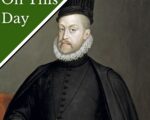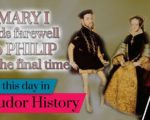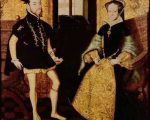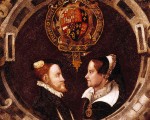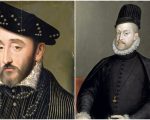On this day in history, 25th July 1554, the feast day of St James, thirty-eight-year-old Queen Mary I married twenty-seven-year-old Philip of Spain, son of Charles V, Holy Roman Emperor, at Winchester Cathedral. Stephen Gardiner, Bishop of Winchester and Mary’s chancellor, officiated.
There is an account of the wedding in Charles Wriothesley’s “A chronicle of England during the reigns of the Tudors, from A.D. 1485 to 1559”:
“The 25 of Julie, beinge Weddensdaye and St. James daye, about xi of the clocke the Kinge and Queene came from their lodgings towardes the churche all the way on foote, verie richelye apparelled in gownes of cloth of golde sett with riche stones, he with his gentlemen and garde and she with hers, eche of them havinge a sworde borne before them, the Earle of Darbye bearinge the sworde before her Maiestie, and the Earle of Pembroke before the Kinge; and when they were come into the churche he went into one traveys and the Queen to another richlye hunge, where they were shriven. This done they came forth of their traveys to the place appoynted for the marriage, where the Lord Chauncellor, beinge before with 5 other bishops assistinge him, used all thinges, both in the banes-byddinge and otherwise, as hath bene in all marriages of olde tyme, and spake it both in Latin and in Englishe, her Grace on the right syde standinge and the King on the left syde. Her marriage ringe was a rownd hoope of gould without anye stone, which was her desire, for she sayde she would be married as maydens were in the olde tyme, and so she was.
[Read More...]
